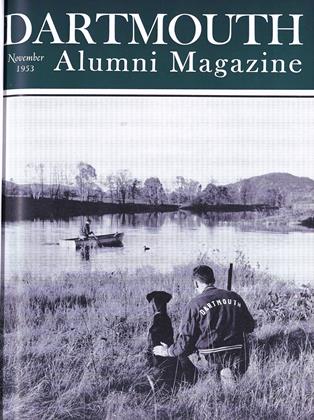THE DARTMOUTH QUARTERLY carries on a tradition developed over nearly seventy years, a tradition of finding and printing the best undergraduate writing. More than any other campus publication it draws on creative imagination in the student body in an attempt to reflect campus life. With ambitions that do credit to the tradition, the editors hope to bring more and better material to their readers to rouse the wider support on which such improvement depends. And not secondarily they hope to renew a long-standing concern with student life. As an aid in so doing the Quarterly intends to publish occasional contributions by well-known writers outside the College to afford undergraduates new opportunities to measure their work against more mature products. Two poems in the last issue by Richard Eberhart '26 reflected this policy, while the poetry of Dilys Laing gave readers a glimpse of more mature work within the college community. The Quarterly hopes also to serve as an outlet for the work of some students in the graphic arts.
That part of Dartmouth tradition the Quarterly preserves has an extensive history. In 1946 the Dartmouth campus was crowded with students newly returned from the war. Their wide experience intensified the desire to communicate, and there was a tremendous outpouring of writing from them. Yet no student literary magazine existed at the time. The Quarterly began in response to this need.
It was a need that had always existed on the campus, and had given rise to a succession of magazines beginning with The Dartmouth Literary Magazine in September 1886. The name changed in 1900 to The Dartmouth Magazine, and in 1906 it disappeared altogether. But students were still writing and needed an outlet for their work. To furnish it The Bema appeared in January 1913.
While The Bema was becoming over a period of seven years "the pictorial monthly of the college," The ThirdRail, A Magazine of Adventure, appeared in 1915 to give further encouragement to student literary endeavors. It was joined in 1922 by a revived Dartmouth Literary Magazine. And no sooner had this come out (shortly to disappear) than in October 1924 TheTower, A Journal of Literature andCriticism, started upon its irregular career. It had expired by June 1929, but in March of that year Sidney Cox launched The Dart. Members of English 3 and 4 worked with Professor Cox to select material from these courses for the magazine.
Between April and June, 1930, three numbers of The Five Arts, a publication in book form, temporarily enlivened the campus. The coming in 1938 of World War II killed The Dart. Not until January 1947 did The DartmouthQuarterly arise to take its place in the succession of Dartmouth literary magazines with, it hopes, a greater degree of permanence than has characterized its predecessors.
One guarantee of a permanent and useful place in the life of the College is the addition of alumni support to that now received from undergraduates and the faculty. In the Quarterly alumni will have an opportunity to know the work of some of the College's most talented and thoughtful undergraduates. As a reflection of present-day Dartmouth and of this rising generation in America, the magazine has a special interest. Dartmouth men of all the classes are welcomed as subscribers.
SINCLAIR H. HITCHINGS '54
EDITORIAL STAFF MEMBERS of "The Quarterly" shown in the Robinson Hall office of the literary magazine are (l to r) Sinclair H. Hitchings '54, James M. Wechsler '55, John L. Callahan '55 and Richard M. Rogin '54.
 View Full Issue
View Full Issue
More From This Issue
-
 Article
ArticleMore Scholarships
November 1953 By ROBERT L. ALLEN '45 -
 Article
ArticleThe Measure of Maturity
November 1953 -
 Class Notes
Class Notes1918
November 1953 By ERNEST H. FARLEY, W. CURTIS GLOVER, RICHARD P. WHITE -
 Article
ArticleThe Faculty
November 1953 By HAROLD L. BOND '42 -
 Class Notes
Class Notes1926
November 1953 By HERBERT H. HARWOOD, H. DONALD NORSTRAND, CARLETON BLUNT -
 Class Notes
Class Notes1916
November 1953 By F. STIRLING WILSON, C. CARLTON COFFIN, H. CLIFFORD BEAN







